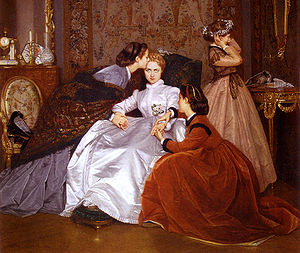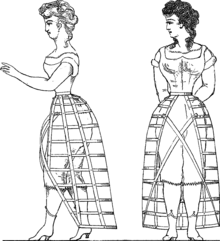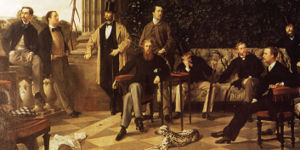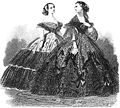| Revision as of 21:02, 30 March 2014 editFlyer22 Frozen (talk | contribs)365,630 editsm Reverted 1 edit by 97.103.34.196 identified as test/vandalism using STiki← Previous edit | Revision as of 19:36, 9 April 2014 edit undoRich Farmbrough (talk | contribs)Edit filter managers, Autopatrolled, Extended confirmed users, File movers, Pending changes reviewers, Rollbackers, Template editors1,725,419 edits →Men's fashionNext edit → | ||
| (2 intermediate revisions by the same user not shown) | |||
| Line 137: | Line 137: | ||
| Overcoats had wide lapels and deep cuffs, and often featured contrasting velvet collars. | Overcoats had wide lapels and deep cuffs, and often featured contrasting velvet collars. | ||
| ]s briefly became the very tall "stovepipe" shape, but a variety of other hat shapes were popular. During this time, the ] gained popularity as an informal hat. This new type of hat was normally made of felt, black for most of the year or brown for the summer months.<ref>{{cite book|last=Byrde|first=Penelope|title= |
]s briefly became the very tall "stovepipe" shape, but a variety of other hat shapes were popular. During this time, the ] gained popularity as an informal hat. This new type of hat was normally made of felt, black for most of the year or brown for the summer months.<ref>{{cite book|last=Byrde|first=Penelope|title=Male Image: Men's Fashion in Britain 1300-1970|date= 8 July 1979|publisher=Batsford|location=Great Britain|ISBN=978-0-7134-0860-7}}</ref> | ||
| In 1865 hatmaker ] invented the ] hat. It gained immediate success in the ] among cowboys and settlers, due to its practicality. It had a vaguely round ribbon-lined crown and a wide brim, originally straight but soon becoming stylized into the iconic rim of the typical cowboy hat. Its dense felt could be rugged enough to carry water. | In 1865 hatmaker ] invented the ] hat. It gained immediate success in the ] among cowboys and settlers, due to its practicality. It had a vaguely round ribbon-lined crown and a wide brim, originally straight but soon becoming stylized into the iconic rim of the typical cowboy hat. Its dense felt could be rugged enough to carry water. | ||
Revision as of 19:36, 9 April 2014

1860s fashion in European and European-influenced clothing is characterized by extremely full-skirted women's fashions relying on crinolines and hoops and the emergence of "alternative fashions" under the influence of the Artistic Dress movement.
In men's fashion, the three-piece ditto suit of sack coat, waistcoat, and trousers in the same fabric emerged as a novelty.
Women's fashions



Colors
Mauveine Aniline dyes (first chemical dyes) were discovered in 1856 and quickly became fashionable colors. The first ones were mauve and bright purple. In 1860, two fashionable brilliant pink aniline dyes were named after battles in Italy's fight for independence: magenta, named after the Italian town of Magenta, Lombardy, and the similar solferino, named after Solferino. Magenta was popularized in England by the Duchess of Sutherland after she was appealed to by the Spitalfields silk weavers.
Gowns
By the early 1860s, skirts had reached their ultimate width. After about 1862 the silhouette of the crinoline changed and rather than being bell-shaped it was now flatter at the front and projected out more behind. This large area was largely occupied by all manner of decoration. Puffs and strips could cover much of the skirt. There could be so many flounces that the material of the skirt itself was hardly visible. Lace again became popular and was used all over the dress. Any part of the dress could also be embroidered in silver or gold. This massive construct of a dress required gauze lining to stiffen it, as well as multiple starched petticoats. Even the clothes women would ride horses in received these sorts of embellishments.
Day dresses featured wide pagoda sleeves worn over undersleeves or engageantes. High necklines with lace or tatted collars or chemisettes completed the demure daytime look.
Evening gowns had low necklines and short sleeves, and were worn with short gloves or lace or crocheted fingerless mitts. Bouffant gowns with large crinolines were probably reserved for special occasions.
Skirts were now assembled of shaped panels, since gathering a straight length of fabric could not provide the width required at the hem without unwanted bulk at the waist; this spelled the end of the brief fashion for border-printed dress fabrics.
Heavy silks in solid colors became fashionable for both day and evening wear, and a skirt might be made with two bodices, one long-sleeved and high necked for afternoon wear and one short-sleeved and low-necked for evening.
As the decade progressed, sleeves narrowed, and the circular hoops of the 1850s decreased in size at the front and sides and increased at the back. Looped up overskirts revealed matching or contrasting underskirts, a look that would reach its ultimate expression the next two decades with the rise of the bustle. Waistlines rose briefly at the end of the decade.
Fashions were adopted more slowly in America than in Europe. It was not uncommon for fashion plates to appear in American women's magazines a year or more after they appeared in Paris or London.
Long coats were impractical with the very full skirts, and the common outer garments were square shawls folded on the diagonal to make a triangle and fitted or unfitted hip-length or knee-length jackets.
Three-quarter-length capes (with or without sleeves) were also worn.
For walking, jackets were accompanied by floor-length skirts that could be looped or drawn up by means of tapes over a shorter petticoat.
fitted jackets with long sleeves, worn over a collared
Undergarments

As skirts became narrower and flatter in front, more emphasis was placed on the waist and hips. A corset was therefore used to help mold the body to the desired shape. This was achieved by making the corsets longer than before, and by constructing them from separate shaped pieces of fabric. To increase rigidity, they were reinforced with many strips of whalebone, cording, or pieces of leather. As well as making corsets more constricting, this heavy structure helped prevent them from riding up, or from wrinkling at the waist. Steam-molding also helped create a curvaceous contour. Developed by Edwin Izod in the late 1860s, the procedure involved placing a corset, wet with starch, on a steam heated copper torso form until it dried into shape. Tight lacing of corsets became even more prominent during this time, as women were often sewn into their stays and released only an hour a week for bathing. The ideal waist size was thirteen inches, yet this was extremely unrealistic. Even with this standard, very few corsets of the period measured less than twenty inches at the waist. Overall, the tight lacing produced "delicious sensations" and an overall erotic appearance of the female physique.
The crinoline or hooped petticoat had grown to its maximum dimensions by 1860. As huge skirts began to fall from favor, around 1864, the shape of the crinoline began to change. Rather than being dome-shaped, the front and sides began to contract, leaving volume only at the back. The "American" cage, a hooped petticoat partially covered in fabric, came in bright colors made possible by the new aniline dyes. This was followed by a hybrid of the bustle and crinoline sometimes called a "crinolette". The cage structure was still attached around the waist and extended down to the ground, but only extended down the back of the wearer’s legs. The crinolette itself was quickly superseded by the true bustle, which was sufficient for supporting the drapery and train at the back of the skirt.
Military and political influences
The Garibaldi shirt or "Garibaldi jacket" was popularized by Empress Eugénie of France in 1860. These bright red woolen garments featured black embroidery or braid and military details. Following a visit by the Italian revolutionary Giuseppe Garibaldi to England in 1863, the shirt became all the rage there. In America, the early years of the Civil War also saw increased popularity of military-influenced styles such as Zouave jackets. These new styles were worn over a waist (blouse) or chemisette and a skirt with a belt at the natural waistline. Women's fashion overall was highly influenced by the reigning Queen Victoria of England.
Rise of haute couture
The Englishman Charles Frederick Worth had established his first fashion house in Paris in 1858. He was the first couturier, a dressmaker considered an artist, and his ability to dictate design in the 1860s lead to the dominance of Parisian haute couture for the next hundred years.
Artistic dress
The followers of the Pre-Raphaelite Brotherhood and other artistic reformers objected to the elaborately trimmed confections of high fashion with their emphasis on rigid corsets and hoops as both ugly and dishonest. An "anti-fashion" for Artistic dress spread in the 1860s in literary and artistic circles, and remained an undercurrent for the rest of the century. The style was characterised by "medieval" influences such as juliette sleeves, the soft colors of vegetable dyes, narrow skirts, and simple ornamentation with hand embroidery.
Hairstyles and headgear
Hair was worn parted in the middle and smoothed, waved, or poofed over the ears, then braided or "turned up" and pinned into a roll or low bun at the back of the neck. Such styling was usually maintained by the use of hair oils and pomades.
Styled hair was often further confined in decorative hairnets, especially by younger women. (NOTE: Though many modern reenactors refer to this garment as a "snood", it is not a period term for this article of clothing; snoods were something else entirely.) These hairnets were frequently made of very fine material to match the wearer's natural hair color, but occasionally more elaborate versions were made of thin strips of velvet or chenille (sometimes decorated with beads). Whether plain or resplendent, many hairnets were edged with ruchings of ribbon that would serve to adorn the crown of the wearer's head.
Fashion Bonnets for outdoor wear had small brims that revealed the face. Earlier bonnets of the decade had lower brims. However, by mid-century Spoon Bonnets, which featured increasingly high brims and more elaborate trimmings, became the vogue. Other less common variants, such as the Marie Stuart Bonnet, with its heart-shaped brim, and the fanchon bonnet, with its very short brim and back curtain, made appearances in the realm of fashionable headwear.

Bonnets could be made of a variety of materials. Bonnets formed from buckram and wire and covered with fashion fabric were very popular. During the warmer seasons, bonnets made of straw, woven horsehair, or gathered net were also seen. Heavier materials like velvet were favored for winter bonnets, though quilted winter hoods were much more practical and warm.
Trimmings varied according to the changing styles and whims of the individual wearer, but most bonnets of the period followed some general rules with regards to form. Rows of gathered net lining the brim was a fashion carry-over from the decade before, and a decorative curtain (also referred to as a "bavolet") appeared on most bonnets in order to shade the wearer's neck and accommodate for the low hairstyles. Another standard of 1860s bonnets is bonnet ties. There were often two sets, a thin pair of "utility ties" to take the strain of tying the bonnet, and another set of wide ties of silk or another fancy material. These rich ties were tied below the chin in a bow or left untied to show off the beautiful print or material.
Bonnets fell out of fashion over the decade in favor of small hats.
Style gallery 1860–1864
- Evening gowns from around 1860 with full skirts held out by crinolines
- Bouffant gowns from the early 1860s.
- Italian woman wears a gray striped jacket with turned-back pagoda sleeves trimmed in contrasting fabric and a matching skirt. Her blouse sleeves or engageantes are full over her lower arms, 1861.
- 1862 portrait of Jenny Lind depicts her in a white evening gown with a wide lace collar. Her hair is parted in the center, rolled or "turned up" at the sides, and decorated with flowers.
- Vienna fashion plate, showing male and female attire.
- Artistic dress has romantic, vaguely medieval lines with a slight train, and is worn without a corset or hoops. This young girl wears her hair down. 1862.
- Zouave jacket in bright red with ball fringe and braid trim is waist length and cutaway in front, 1864.
- Fashion plate of 1864 shows the fashionable braided Zouave-style cutaway jacket worn with a shirtwaist (blouse), skirt, and wide belt. The lady on the right wears a knee-length velvet coat.
Style gallery 1865–1866
-
 1 – 1865
1 – 1865
- 2 – 1865 2 – 1865
-
 3 – 1865
3 – 1865
-
 4 – 1865
4 – 1865
-
 5 – 1865
5 – 1865
-
 6 - c. 1865
6 - c. 1865
-
 7 – 1866
7 – 1866
- Emilia Włodkowska wears a bronze-colored satin evening gown with bands of trim on the skirt, 1865.
- The Empress Elisabeth in evening dress, 1865. The skirt has an overlayer of sheer fabric called illusion and is noticeably fuller in back than in front, the first hint of the styles that would prevail in the next decade.
- Clara Barton wears a typical American hairstyle of 1865–66.
- Countess Karoly wears her hair in a net or snood. Her hat is tipped forward over her forehead, and is trimmed with ostrich plumes, 1865.
- Ellinor Guthrie wears a black satin dress trimmed with passementerie, 1865.
- English shot (changeable) silk taffeta morning dress is trimmed with silk satin and machine-made lace, c. 1865. Los Angeles County Museum of Art, M.2007.211.942a-b.
- Emilie Menzel wears her hair in a net snood. Her morning dress has a pointed waist and slightly puffed, long sleeves, 1866.
Style gallery 1867–1869
- Riding habits of 1867 feature short to hip-length jackets and trailing petticoats for riding sidesaddle.
- Fashions of May 1868. Paris designs for May 1868. Relatively understated but showing developing back detail.
- Margherita of Savoy-Genoa wears an outdoor walking costume consisting of a loose jacket and matching skirt. The skirt is drawn up for ease of walking over an ankle-length underskirt or petticoat and hoops. She wears a bowler-like hat wrapped in a scarf or veil. Latter half 1860s.
- Fashions of 1869 show a high waist and an elliptical skirt. Draped styles suggest a separate underskirt or petticoat. Jackets are knee-length.
- Fashions from The Englishwoman's Domestic Magazine, 1869, show the beginnings of the bustle: high-waisted skirts are looped up over underskirts. Hats are worn tipped forward over the forehead, and short gloves are worn with long, tight sleeves.
- Photo of bustle cage crinoline (1862–70) and split-busk corset (1865–75), Los Angeles County Museum of Art M.2007.211.386, M.2007.211.360
Men's fashion

Men's fashion of the 1860s remained much the same as in the previous decade.
Shirts of linen or cotton featured high upstanding or turnover collars, and neckties grew wider and were tied in a bow or looped into a loose knot and fastened with a stickpin. Heavy padded and fitted frock coats (in French redingotes), now usually single-breasted and knee length, were worn for business occasions, over waistcoats or vests with lapels and notched collars. Waistcoats were generally cut straight across the front and had lapels.
The loosely fitted, mid-thigh length sack coat continued to slowly displace the frock coat for less-formal business occasions.
The slightly cutaway morning coat was worn for formal day occasions. The most formal evening dress remained a dark tail coat and trousers, with a white cravat; this costume was well on its way to crystallizing into the modern "white tie and tails". While during the first half of the decade the waist was long, after 1865 the waist became shorter, with pockets in the pleats.
Full-length trousers were worn, generally of a contrasting fabric. Costumes consisting of a coat, waistcoat and trousers of the same fabric (called a "ditto suit") remained a novelty at this time. In domestic settings, the sack coat or a lounge jacket could be worn with a waistcoat and trousers of the same fabric. This form of ditto suit, referred to as a lounge suit in the United Kingdom was generally made of wool, with baggy tailoring. However, the lounge suit was not considered appropriate for public settings until the 1870s.
Overcoats had wide lapels and deep cuffs, and often featured contrasting velvet collars.
Top hats briefly became the very tall "stovepipe" shape, but a variety of other hat shapes were popular. During this time, the bowler hat gained popularity as an informal hat. This new type of hat was normally made of felt, black for most of the year or brown for the summer months.
In 1865 hatmaker John B. Stetson invented the Boss of the Plains hat. It gained immediate success in the Old West among cowboys and settlers, due to its practicality. It had a vaguely round ribbon-lined crown and a wide brim, originally straight but soon becoming stylized into the iconic rim of the typical cowboy hat. Its dense felt could be rugged enough to carry water.
Style gallery
- Eduard de Stoeckl wears a frock coat over a waistcoat with a low front and lapels. He wears a patterned tie. 1855–65.
- Manet's unidentified man wears a tie secured with a jewel at the neck, a shawl-collared waistcoat, and a contrasting coat, 1860.
- George Augustus Sala wears an overcoat with black velvet collar, wide lapels, and deep cuffs over a frock coat, waistcoat, and tweed trousers. He wears leather gloves and carries a top hat. c. 1860–65.
- William Curtis Noyes wears an overcoat with very wide lapels, wide cuffs, a contrasting (probably velvet) collar, and braid trim over a frock coat, waiscoat, and trousers which appear to be made of matching fabric. The ends of his large necktie are loosely looped and secured with a stickpin, and then tucked into his waistcoat. 1855–65.
- John Tyler wears a cravat tied in a floppy bow. His coat has wide lapels and contrasting waistcoat have wide lapels, 1860–65.
- Wilhelm Taubert wears a dark necktie tied in a bow and slightly winged collar. German, 1862.
- Thomas D'Arcy McGee wears a dark double-breasted frock coat over a high-buttoned single-breasted waistcoat and trousers., 1868.
- Note: Photographs from the Library of Congress's Brady-Handy collection are collectively dated 1855–1865. Where possible, tighter dates have been applied based on known facts about the sitters. See Mathew Brady.
Children's fashion
Both boys and girls wore skirts from the time they could walk until they reached age 5 or 6. Very small girls wore their skirts just below knee-length over pantalettes. Skirts were longer as girls grew up until they reached floor length at coming-out (in their later teens). Older girls wore hoops to hold out their skirts. Young girls wore washable pinafores over their dresses for work and play to keep them clean, as typified by the eponymous heroine of Lewis Carroll's 1865 novel, and her Alice in Wonderland dress .
Boys wore simple jackets and trousers.
-
 Alice Liddell, 1860
Alice Liddell, 1860
-
 Girls in pinafores, 1860–62
Girls in pinafores, 1860–62
-
 Germany, 1861
Germany, 1861
-
 Boy, 1867
Boy, 1867
-
 English boy, 1869
English boy, 1869
See also
Notes
- Travis, Anthony S., "Perkin’s Mauve: Ancestor of the Organic Chemical Industry", Technology and Culture 31 (1), 1990 pp. 51–82
- ^ Cunnington, C. Willett, English Women's Clothing in the Nineteenth Century, Dover Publications, Inc. New York 1990 ISBN 0-486-26323-1, page 208
- Worsley-Gough, Barbara, Fashions in London, Allan Wingate Publishers Ltd., London, England 1952, pp. 69–70
- http://www.vam.ac.uk/collections/fashion/features/corset/1830/index.html
- Kohler, Carl (1963). A History of Costume. New York: Dover Publications.
- ^ Takeda and spilker (2010), p. 96
- 1860s corsets
- Kemper, Rachel H: "Costume" (1992) pg 131
- Takeda and Spilker (2010), p. 99.
- Young, Julia Ditto, "The Rise of the Shirt Waist", Good Housekeeping, May 1902, pp. 354–357
- Cunnington, Phillis and C. Willet (1970). Handbook of English Costume in the Nineteenth Century. Boston: Plays, Inc. p. 227.
- Ashelford, Jane (1996). The Art of Dress: Clothes and Society 1500-1914. Great Britain: National Trust Enterprises Limited. pp. 215–216. ISBN 0-8109-6317-5.
- Byrde, Penelope (8 July 1979). Male Image: Men's Fashion in Britain 1300-1970. Great Britain: Batsford. ISBN 978-0-7134-0860-7.
References
- Arnold, Janet: Patterns of Fashion 2: Englishwomen's Dresses and Their Construction C.1860–1940, Wace 1966, Macmillan 1972. Revised metric edition, Drama Books 1977. ISBN 0-89676-027-8
- Ashelford, Jane: The Art of Dress: Clothing and Society 1500–1914, Abrams, 1996. ISBN 0-8109-6317-5
- Goldthorpe, Caroline: From Queen to Empress: Victorian Dress 1837–1877, Metropolitan Museum of Art, New York, 1988, ISBN 0-87099-535-9 (full text available online from the Metropolitan Museum of Art Digital Collections)
- Johnston, Lucy: From the Crinoline, to the Crinolette, to the Bustle: 1860–1880, V&A Museum, Collections, Corsets and Crinoline.
- Payne, Blanche: History of Costume from the Ancient Egyptians to the Twentieth Century, Harper & Row, 1965. No ISBN for this edition; ASIN B0006BMNFS
- Steele, Valerie: Paris Fashion: A Cultural History, Oxford University Press, 1988; ISBN 0-19-504465-7
- Takeda, Sharon Sadako, and Kaye Durland Spilker, Fashioning Fashion: European Dress in Detail, 1700 - 1915, Prestel USA (2010), ISBN 978-3-7913-5062-2
- Tortora, Phyllis G. and Keith Eubank. Survey of Historic Costume. 2nd Edition, 1994. Fairchild Publications. ISBN 1-563-67003-8
- Tozer, Jane, and Sarah Levitt: Fabric of Society: A Century of People and Their Clothes 1770–1870, Laura Ashley Ltd., 1983; ISBN 0-9508913-0-4
External links
- 1860s Fashion Plates of men, women, and children's fashion from The Metropolitan Museum of Art Libraries
- 1850s and 1860s Fashion
- 1860s Men's Fashions — circa 1860 Men's Fashion Photos with Annotations
- Garibaldi jacket
- Photographs of Women from the American Civil War Period c. 1859-1865 (with notes on costume and hairstyles)
- 1864 Wedding Dress — Metropolitan Museum of Art Costume Institute
- 1860s Fashions in the Staten Island Historical Society Online Collections Database





















